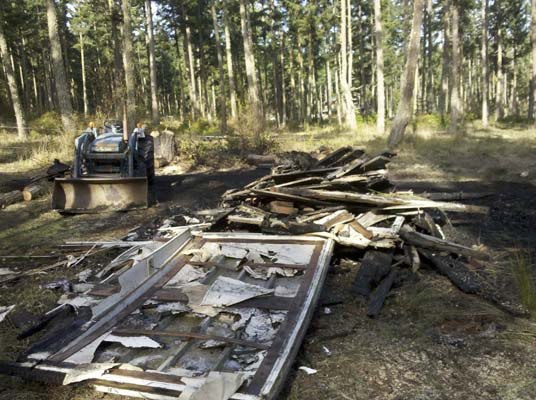By Cali Bagby
A Lopez man had an unusual – and illegal – idea of how to set a 42-foot grounded boat on fire.
He threw a few flares inside and the boat burned to the ground.
The individual responsible was given a ticket for the maximum fine of $500 for burning unauthorized materials, plus around $2,900 — the cost of fire suppression, which included three fire engines and about 16 fire personnel sent to put out the fire.
“You can burn only natural vegetation,” said San Juan County Deputy Fire Marshal Paul Turner. “Milled lumber — like the boat, asphalt and a whole other list of things are unauthorized materials.”
Basically, if it doesn’t grow in the ground, it can’t be burned. It’s a rule that Turner strictly enforces.
Since the boat fire, Turner has received several reports of illegal burnings on Lopez, and countywide Turner has responded to cases of residents burning without a permit and in some instances, setting fire to garbage, fiberglass items, and paper products.
Turner has issued one citation for illegal burning on Lopez this year. Last year at this time, that number was zero.
“That doesn’t mean it’s not happening,” Turner said. “This problem exists countywide and the fire marshal office will respond and citations will be given.”
The maximum fine for burning without a permit is $250 on all three islands and the maximum fine for burning unapproved materials is $500. Both require a court appearance.
Turner urges citizens to call 911 if they suspect an illegal burning.
“If a fire doesn’t smell like a campfire, there’s junk in it,” Turner said about ways to identify what people are burning.
What and when you can burn
Unless there is a burn ban, the fire marshal allows recreational fires of two feet in diameter during any time of the year.
The open burning season is Oct. 1 through June 30.
For residential burn piles, which are 10 by 10 feet or less, a $15 permit is required.
Commercial permits are needed for larger burns (40 by 40 feet); they are $225 and valid for 30 days. Heavy equipment – such as an excavator – is required to be on scene.
Permits can be obtained online at www.sjcfiremarshal.org or at any of the island fire departments.
Anyone living within an Urban Growth Area cannot have a residential burn pile. Only a two-foot recreational fire is permitted.
According to the Washington Clean Air Act of 1970, only natural vegetation may be burned. The following materials are not allowed: garbage, dead animals, petroleum products, paints, plastics, paper (other than what is necessary to start a fire), cardboard, treated wood, construction/demolition debris, metal, or any substance that releases toxic emissions, dense smoke, or obnoxious odors when burned.
“You can’t take cardboard boxes, light them on fire, and put wood on top,” Turner said. “You can’t burn anything except natural vegetation.”





